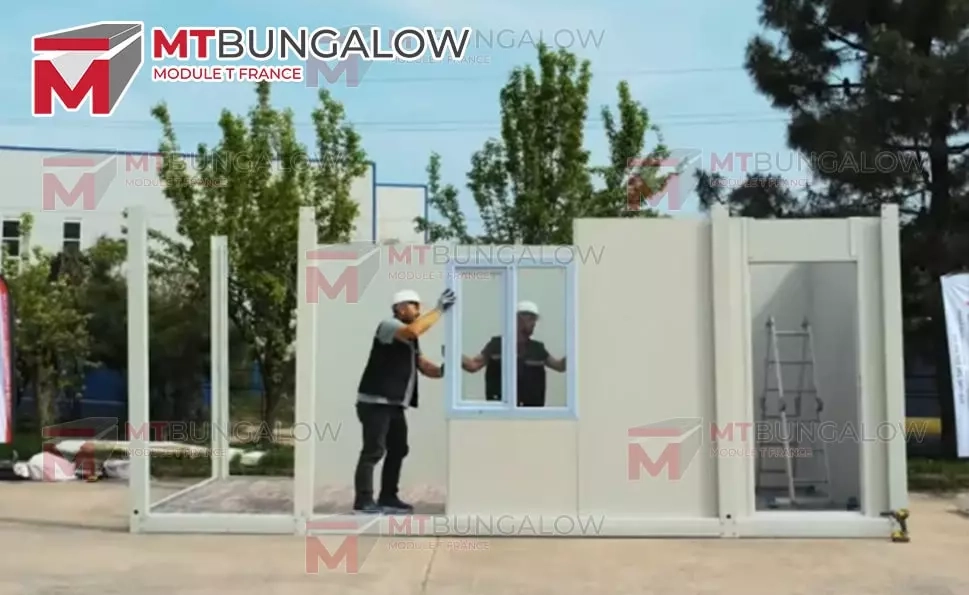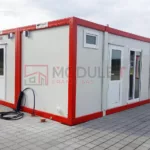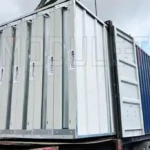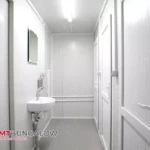Introduction – Legal and Compliant from Day One
The construction site cabin has become an essential tool for organizing and securing a construction site. Whether used as an office, changing room, base camp, or dining hall, it provides a functional space for teams and contributes to the smooth running of operations.
But before the crane truck arrives, it's essential to ensure that the installation complies with all legal requirements. Building permits, prior declarations, compliance with the Labor Code, specific authorizations... The regulations are precise, and failure to comply can result in sanctions or even a temporary shutdown of the construction site.
This guide takes you step by step to understand the steps to take and anticipate deadlines, so that your construction site bungalow is not only operational, but also fully compliant.
1. Temporary or permanent installation: the first distinction
The duration of the bungalow's installation is the first criterion which determines your administrative obligations.
Less than 4 months: temporary installation
According to the Urban Planning Code, a bungalow installed for a period of less than 4 months generally does not require a building permit or prior declaration, provided that it is removed at the end of this period. This rule often applies to short-term construction sites or one-off interventions.
More than 4 months: sustainable installation
If the duration of implantation exceeds 4 months, the regulations change:
- For an area less than 20 m²: a prior declaration to the town hall is required.
- For an area greater than 20 m²: a building permit is required.
These thresholds relate to the total floor area of the installed modules, whether isolated or assembled.
2. Obligations of the Labor Code: toilets, changing rooms, canteens
Beyond town planning formalities, the installation of a construction site bungalow must comply with the health obligations defined by the Labor Code.
For a construction site lasting more than 4 months, the law requires the installation of a complete base camp including:
- Sufficient number of toilets, separated for men and women.
- Sinks with drinking water.
- Changing rooms equipped with individual seats and lockers.
- A dining area or refectory with tables and chairs.
- Showers when the construction site involves dirty or dangerous work.
These facilities must be kept in a good state of cleanliness and accessible to workers at all times.
For more information: consult our guide dedicated to construction site toilets and changing rooms as well as our page on modular living quarters.
3. Essential administrative procedures
Check the PLU (Local Urban Planning Plan)
Before any installation, it is essential to consult the municipality's PLU. This document may set specific rules: distances from property boundaries, aesthetics of installations, prohibited areas.
Ask for the town hall's agreement
In the event of a prior declaration or permit application, the file is submitted to the town hall of the location of the establishment. It must contain:
- A location plan.
- A site plan.
- A descriptive notice of the bungalow and its use.
- Photographs or graphic representations.
Comply with fire and accessibility standards
Bungalows intended to accommodate the public or a large number of workers must meet specific requirements: door width, emergency exits, fireproof materials, etc.
4. Authorization to occupy public property
When the bungalow encroaches on a public highway, a parking permit or temporary occupation permit (AOT) is required. This is often the case when the construction site is in a city center or high-density area.
This request should be made to the town hall or the local authority managing the road network. It should be anticipated, as response times can vary from a few days to several weeks.
5. Transport and traffic: anticipating constraints
Delivering a modular bungalow often involves the use of heavy goods vehicles and sometimes a crane truck. As Jamart points out, specific permits may be required for the movement of oversized equipment or prolonged parking on the street.
These logistical constraints must be integrated into the overall schedule: they can influence the installation date and require precise coordination between the supplier, the transporter and the crane operator.
6. Prepare a complete and precise file
A well-presented file increases your chances of quickly obtaining the necessary authorizations. It must include:
- Dimensioned plans of the bungalow and its layout.
- Technical details (dimensions, weight, connections).
- A notice describing the use (office, base camp, sanitary facilities, etc.).
- The measures planned to respect safety and hygiene.
By anticipating possible requests for additional information, you avoid administrative back-and-forth and save time.
7. Anticipate deadlines and coordinate stakeholders
Meeting deadlines is a major challenge on a construction site. Obtaining a building permit can take several weeks, or even several months in the case of a complex application.
It is therefore advisable to:
- Start the administrative procedures before ordering.
- Plan delivery based on the expected date of obtaining authorizations.
- Synchronize preparatory work (earthworks, networks) with the installation date.
8. Concrete example – Installation of a base camp in an urban area
On a rehabilitation project in the city center, the company had to install an 8-unit living base on land partly located on public property. The town hall demanded:
- A temporary occupation permit for the part encroaching on the roadway.
- A specific traffic plan during deliveries.
- Limited crane hours to reduce disruption.
By anticipating these steps and working with an experienced supplier, the work was able to start on the scheduled date, without delays due to formalities.
9. Carrier or crane operator standards and certifications
Installing a construction site bungalow involves more than just delivering it to the site. It involves a chain of responsibility, with each participant—from the supplier to the crane operator—must meet strict regulatory and technical requirements. To ensure the safety, reliability, and compliance of the operation, it's essential to rely on certified partners.
At MT Bungalow, we rigorously select our logistics providers. Our partner carriers and crane operators hold the main certifications in the construction industry:
- CACES (Certificate of Aptitude for Safe Driving) for lifting equipment operators,
- ISO 9001 for quality management,
- QUALIBAT for technical skills and regulatory commitment.
These certifications are a guarantee of reliability, but also a guarantee in the event of an incident. Each stage of transport or lifting is covered by specific insurance, protecting the customer against possible damage to modules, infrastructure, or third parties.
This rigor in our selection of partners allows MT Bungalow to offer a controlled service from start to finish, from ordering to installation. To go further, our guides dedicated to kit installation or modular base camps also explain the importance of these requirements in a real-world context.
10. Why choose an “all-in-one” provider like MT Bungalow?
Organizing delivery, transportation, lifting, installation, and sometimes administrative procedures can quickly become a logistical headache for a project owner or general contractor. That's why using an all-in-one service provider like MT Bungalow makes all the difference.
With us, a single point of contact centralizes all operations. We provide:
- the preparation of modules in the factory,
- logistical coordination with certified carriers and crane operators,
- verification of on-site feasibility,
- planning the installation according to your site requirements.
This integrated approach not only saves time, but also prevents miscommunication between multiple subcontractors. The result: reduced overhead costs associated with delays or last-minute adjustments, and consistent delivery from day one.
By choosing MT Bungalow, you're opting for a turnkey solution designed for demanding construction professionals. Our team is committed to supporting you every step of the way, drawing on field expertise and a thorough understanding of industry standards.
Conclusion – A compliant bungalow, a peaceful construction site
Installing a construction site bungalow isn't just about choosing a model and installing it on site. It also means complying with a specific regulatory framework that protects workers, secures facilities, and ensures compliance with local authorities.
By following these steps – distinguishing between temporary and permanent installation, compliance with health requirements, administrative procedures, specific authorizations – you ensure that your bungalow is perfectly legal and ready for use.
For complete support, from choosing the model to managing formalities, MT Bungalow provides you with its expertise and turnkey solutions.




